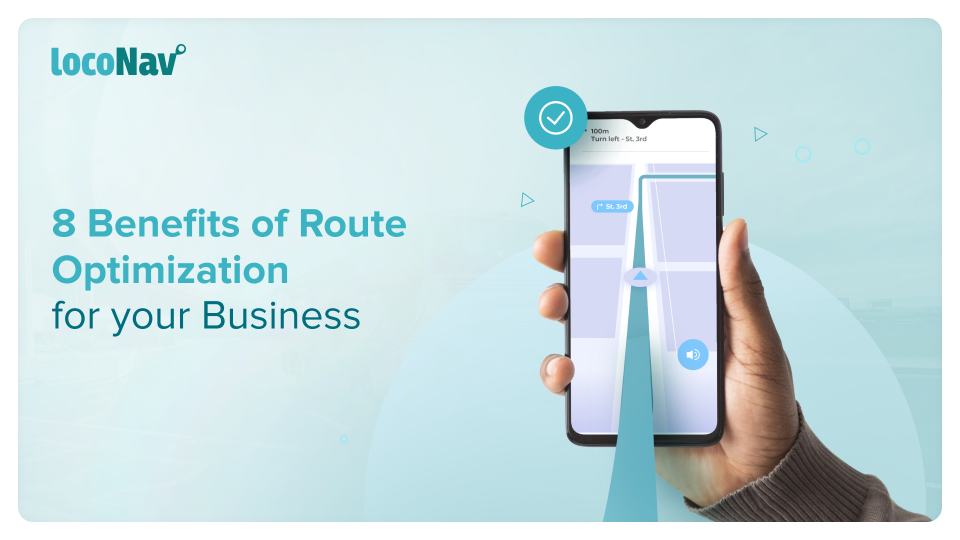

Without the correct tools, planning dozens or hundreds of delivery routes is nearly impossible.
Sure, some people prefer to dispatch packages as they arrive at the warehouse rather than arrange them ahead of time. The issue with this is that numerous delivery truck drivers may be sent to the same neighborhood at the same time.
Even minor changes to your driver’s route plan can not only help you deliver items or serve your clients more quickly, but they can also have a big influence on your bottom line. With the right route optimization technologies, your company might save up to 20% on mileage and increase order capacity by up to 100% without expanding its fleet.
In this blog, we’ll explain exactly what route optimization is and how it can benefit your business.
What is Route Optimization?
The process of determining the optimum path for delivery vehicles to travel in order to get a delivery from the transit hub to its final recipient as fast and cost-effectively as possible is known as route optimization.
This may not always imply taking the shortest path. It’s more concerned with minimizing total drive time when making a number of stops, taking into account a slew of variables such as:
- Vehicle Capacity
- Delivery Window
- Traffic
- Driver Availability
Finding the optimum routes is a time-consuming (and perhaps difficult) procedure when done manually. If you only have a few vehicles with ten stops apiece, there are practically millions of potential route options.
Humans lack the mental bandwidth to effectively account for all of the various variables that can affect a route, as well as the ability to accurately choose the most effective approach based on the information.
Even if you could, maintaining those delivery routes would take up an inordinate amount of time. This has the potential to significantly increase your operating costs due to issues such as overbooking vehicles and excessive fuel use.
Benefits of Route Optimization for your Business
With an increasing competitive edge in every business, the supply chain industry demands innovative technology to automate logistics from beginning to end in order to save time and effort, enhance productivity, and reduce human dependency. A solid route optimization software aids in the optimization of the distribution and on-ground processes such as shipping, transporting, last-mile delivery, and return logistics. It employs sophisticated algorithms and Artificial Intelligence (AI) to determine the shortest and most efficient path to all stops and destinations.
A compatible Route Optimization tool will give you the following benefits:
Safer Driving
Route optimization can be set to use lesser left turns or U-Turns, as these are more likely to have an accident than straight or completing right turns. When a route is planned ahead of time, the driver may concentrate on the road rather than making choices about the next stop or which detour to take to reach the destination.
Increased Visibility
Route optimization can keep a real-time eye on the delivery business, responding to customer queries and supply chain management and drivers. By using real-time GPS and maps to illustrate the routes, dispatchers can ensure that drivers are not violating speed restrictions or taking unnecessary breaks.
Reduced Maintenance Costs
Route optimization might help you save money on car maintenance. The vehicles are driven for fewer hours, resulting in fewer wasted miles. This results in less wear and tear as well as cheaper fuel expenses.
Fleet managers can use route optimization technologies to guarantee that the correct number of drivers are booked, accounting for delivery numbers that do not exceed regulatory rules for how long drivers can be behind the steering wheel.
Faster Deliveries
Route Optimization significantly cuts down on delivery times. Order delivery timeframes have come under increased scrutiny as a result of offering end-to-end shipment tracking, prompting some merchants and carriers to wonder why it might take so long for one product and not as long for another.
This is all part of the eCommerce giants effect, which is the mistaken notion held by many consumers that because certain players can deliver in two days, every eCommerce firm should do the same. Regardless of how feasible this is, it is a problem that has driven numerous eCommerce companies and carriers to examine their delivery procedure and speed in order to improve.
Reducing Fuel Expenditure
Route optimization can help you save a lot of money on gas. Fuel consumption can be reduced by using highway driving instead of city roads with stops and starts, and by choosing the most efficient way using an algorithm rather than guessing.
Improved Efficiency
When it comes to logistics, deliveries must be tracked on a regular basis in order to make adjustments and maintain maximum efficiency. By measuring key performance indicators (KPIs) such as on-time percentages, successful deliveries, tracking fuel usage, average time, customer review rating, idling time, and drop-offs per pickup (via built-in reporting tools), you may identify areas for improvement in order to reduce expenses and increase revenues.
Eliminating Human Errors
Using a route optimization service, as opposed to manual route planning, decreases the risks of making errors, especially if the route is intricate or there are many aspects to consider. Instead, fleet management can use their time to fix other problems or improve service quality in other ways.